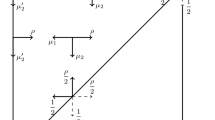Abstract
This paper introduces a new class of queues which are quasi-reversible and therefore preserve product form distribution when connected in multinode networks. The essential feature leading to the quasi-reversibility of these queues is the fact that the total departure rate in any queue state is independent of the order of the customers in the queue. We call such queues order independent (OI) queues. The OI class includes a significant part of Kelly's class of symmetric queues, although it does not cover the whole class. A distinguishing feature of the OI class is that, among others, it includes the MSCCC and MSHCC queues but not the LCFS queue. This demonstrates a certain generality of the class of OI queues and shows that the quasi-reversibility of the OI queues derives from causes other than symmetry principles. Finally, we examine OI queues where arrivals to the queue are lost when the number of customers in the queue equals an upper bound. We obtain the stationary distribution for the OI loss queue by normalizing the stationary probabilities of the corresponding OI queue without losses. A teletraffic application for the OI loss queue is presented.
Similar content being viewed by others
References
J.M. Akinpelu, The overload performance of engineered networks with nonhierarchical and hierarchical routing, Int. Teletraffic Congr. 10 (1983) 3.2.4.1–3.2.4.7.
F. Baskett, K.M. Chandy, R.R. Muntz and J. Palacios, Open, closed and mixed networks of queues with different classes of customers, J. ACM 22 (1975) 249–260.
S.A. Berezner and A.E. Krzesinski, Blocking probabilities in large circuit-switched networks with common channel signalling, in:Proc. Australian Telecommunications Networks and Applications Conference, Melbourne, Australia (1994).
J.-Y. Le Boudec, A BCMP extension to multiserver stations with concurrent classes of customers, in:Proc. 1986 ACM Sigmetrics Conf., Perform. Eval. Rev. 14 (1986) 78–91.
D.Y. Burman, J.P. Lheoczky and Y. Lim, Insensitivity of blocking probabilities in a circuit-switching network, J. Appl. Prob. 21 (1984) 850–859.
X. Chao and M. Pinedo, On generalized networks of queues with positive and negative arrivals, Prob. Eng. Inf. Sci. 7 (1993) 301–334.
S. Crosby and A.E. Krzesinski, Product form solutions for multiserver centers with concurrent classes of customers, Perform. Eval. 11 (1990) 265–281.
S. Crosby, A.E. Krzesinski and J.-Y. Le Boudec, A MSCCC model of multilayer window flow control, in:5th Int. Conf. on Modeling Techniques and Tools for Computer Performance Evaluation, eds. G. Balbo and G. Serazzi (Elsevier, 1992).
J.M. Harrison and R.J. Williams, On the quasi-reversibility of a multiclass Brownian station, Ann. Prob. 18 (1990) 1249–1268.
W. Henderson, C.E.M. Pearce, P.K. Pollett and P.G. Taylor, Connecting internally balanced quasi-reversible Markov processes, Adv. Appl. Prob. 24 (1992) 934–959.
K.B. Irani and I.H. Önyüksel, A closed-form solution for the analysis of multiple-bus multiprocessor systems, IEEE Trans. Comp. C-33 (1984) 1004–1012.
J.R. Jackson, Networks of waiting lines, Oper. Res. 5 (1957) 518–521.
F.P. Kelly,Reversibility and Stochastic Networks (Wiley, 1979).
F.P. Kelly, Networks of quasi-reversible nodes, applied probability — Computer science, the interface,Proc. ORSA-TIMS Boca Raton Symp., ed. R. Disney (Birkhauser Boston, Cambridge, MA, 1981).
F.P. Kelly, Blocking probabilities in large circuit-switching networks, Adv. Appl. Prob. 18 (1986) 473–505.
A.E. Krzesinski and R. Schassberger, The multiserver center with hierarchical concurrency constraints, Prob. Eng. Inf. Sci. 6 (1992) 147–156.
M.A. Marsan, G. Balbo, G. Chiola and S. Donatelli, On the product form solution of class of multiple-bus multiprocessor system models, J. Syst. Software 1 (1986) 117–124.
Mitra, Asymptotic analysis and computational methods for a class of simple circuit-switched networks with blocking, Adv. Appl. Prob. 19 (1987) 219–239.
R.R. Muntz, Poisson departure processes and queueing networks, IBM Research Report RC4145, IBM Thomas J. Watson Research Center, Yorktown Heights, New York (1972).
R.D. Nelson, The mathematics of product form queueing networks, ACM Comp. Surv. 25 (1993) 339–369.
P.K. Pollett, Connecting reversible Markov processes, Adv. Appl. Prob. 18 (1986) 880–909.
P.K. Pollett, Preserving partial balance in continuous-time Markov chains, Adv. Appl. Prob. 19 (1987) 431–453.
J. Walrand and P. Varaiya, Interconnections of Markov chains and quasi-reversible queueing networks, Stoch. Processes and Appl. 10 (1980) 209–219.
J. Walrand,An Introduction to Queueing Networks (Prentice-Hall, 1988).
J. Walrand, A probabilistic look at networks of quasireversible queues, IEEE Trans. Inf. Theory IT-29 (1983) 825–831.
P. Whittle,Systems in Stochastic Equilibrium (Wiley, 1986).
Author information
Authors and Affiliations
Rights and permissions
About this article
Cite this article
Berezner, S.A., Kriel, C.F. & Krzesinski, A.E. Quasi-reversible multiclass queues with order independent departure rates. Queueing Syst 19, 345–359 (1995). https://doi.org/10.1007/BF01151928
Received:
Revised:
Issue Date:
DOI: https://doi.org/10.1007/BF01151928




